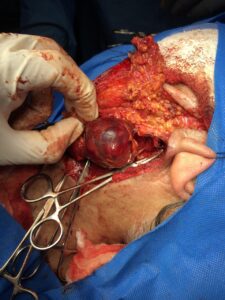PHRYGIAN CAP GALLBLADDER (OCT. 2021)
Review of literature
The gallbladder is a pear-shaped organ and stores bile. Normally, the gallbladder is about 7 cm long and 3 cm wide and is located on the undersurface of the liver. Since the introduction of cholecystectomy in 1882 [1], many gallbladder variations are known. These variations include anomalies of form, location or number of gallbladders. Gallbladder anomalies arise from changes in embryological development. During the fourth week of gestation, the liver, gallbladder and biliary tree arise as a ventral bud from the most caudal part of the foregut [2, 3]. The original hepatic diverticulum differentiates caudally into the gallbladder [3]. A folding of the fundus during embryological development causes a so-called Phrygian cap. A Phrygian cap is a congenital abnormality of the gallbladder [4, 5] and has an incidence of 4% [6]. It is the most common congenital anomaly of the gallbladder and can simulate a mass in the liver during hepatobiliary imaging [5], which may suggest a tumour. It can also simulate a duplication of the gallbladder [7]. A Phrygian cap, however, has no pathological significance. It is therefore important to use proper imaging techniques to differentiate between a Phrygian cap and other diagnoses.
We report the case of an elderly patient with symptomatic cholelithiasis underwent laparoscopic cholecystectomy and incidental finding of PHRYGIAN CAP GALLBLADDER.
References
- Hardy KJ. Carl Langenbuch and the Lazarus Hospital: events and circumstances surrounding the first cholecystectomy. Aust N Z J Surg. 1993;63:56–64.
- Severn CB. A morphological study of the development of the human liver. 1. Development of the hepatic diverticulum. Am J Anat. 1971;131:133–158.
- Rappaport AM, Wanless IR. Diseases of the Liver. ed 7. Philadelphia: Lippincott; 1993. p. 1.
- De Csepel J, Carroccio A, Pomp A. Soft-tissue images. ‘Phrygian cap’ gallbladder. Can J Surg. 2003;46:50–51.
- Lamah M, Karanjia ND, Dickson GH. Anatomical variations of the extrahepatic biliary tree: review of the world literature. Clin Anat. 2001;14:167–172.
- Edell S. A comparison of the Phrygian cap deformity with bistable and gray scale ultrasound. J Clin Ultrasound. 1978;6:34–35.
- Dalal S, Chauhan TS, Kumar R, Choudhury SR. Pseudo-duplication of the gall bladder due to Phrygian cap – a case report. Internet J Surg. 2013;29








